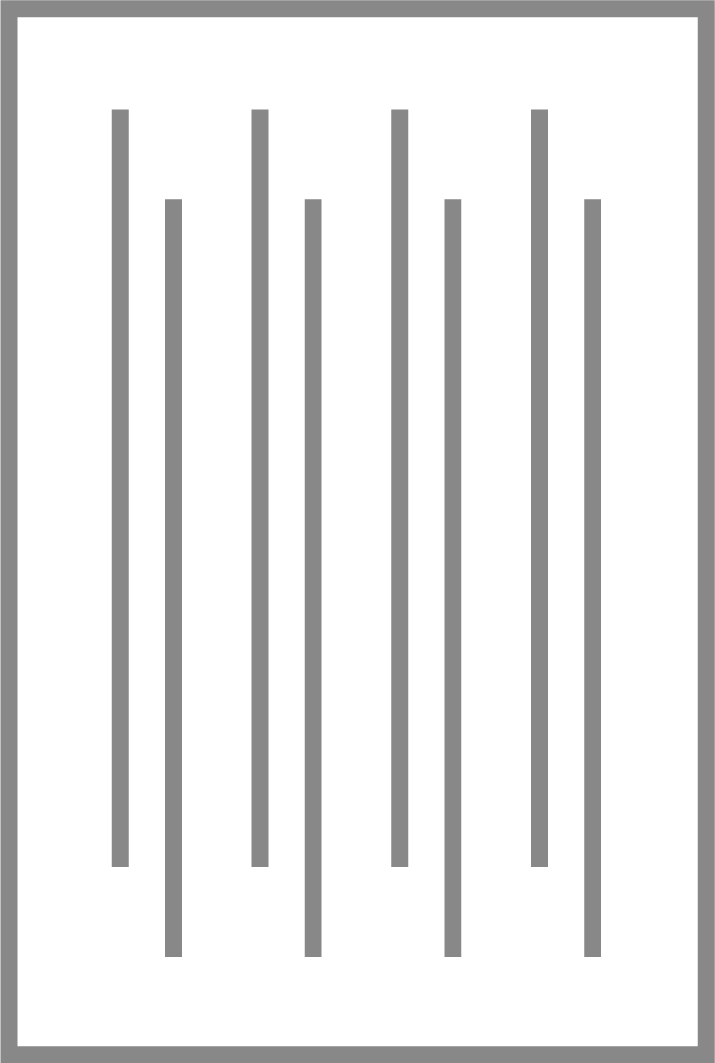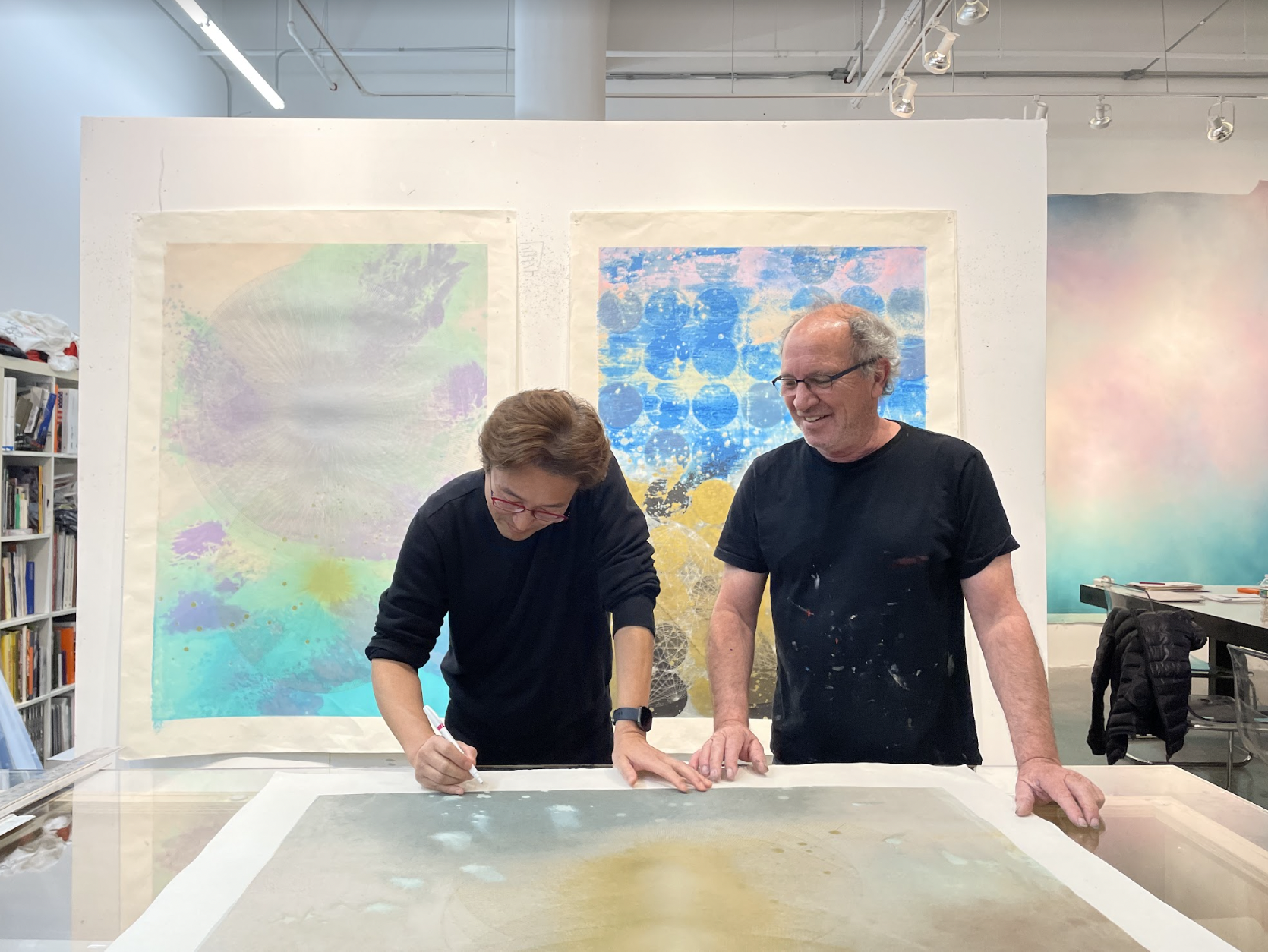EMBRACE
The Journey of Gary Lichtenstein
Waterfall and Gary Lichtenstein’s decade-long relationship has inspired the first exhibition of 2023 in honor of their friendship and the artist's accomplished life.
Over the course of his remarkable 45-year career as a silkscreen printer, Lichtenstein has worked with over 90 artists, each of whom has approached the medium of silkscreen with their own unique and specific intentions. Every project produced in Lichtenstein's studio, including his own, tells a different story. The exhibition <EMBRACE> celebrates the journey of Lichtenstein and showcases the selected collaborative series of silkscreen prints of historically exhibited Waterfall artists, Robert Indiana, Charles Hinman, Makoto Fujimura, and Jinwon Chang.
Renowned painter Gary Lichtenstein demonstrates true abstract expressionism with his spectacular use of color. His paintings, more than 200 oil-based works to date, exhibit mastery of the properties of light absorption and reflection, specifically with regard to the visual impact of color. The composition of Lichtenstein’s work has been referred to as atmospheric…”evocative of natural forms and phenomena.” The inclusion of his 18 foot long paintings ‘Reflection’ and ‘Quiet Sky’ will be displayed alongside Yuyu Yang’s ‘East and West Gate’ reflective sculpture. Inspired by artists such as Robert Motherwell and Helen Frankenthaler, Lichtenstein creates canvases which have frequently been described as ethereal, and he has been praised as one who manages to capture a “sense of no-self…”
<Embrace> will be a preview of Lichtenstein's solo exhibition presented at The Butler Institute of American Art in Youngstown, Ohio this upcoming spring.
Robert Indiana
Robert Indiana (1928-2018), one of the preeminent figures in American art since the 1960s, has played a central role in the development of assemblage art, hard-edge painting and Pop art. A self proclaimed “American painter of signs,” Indiana has created a highly original body of work that explores American identity, personal history and the power of abstraction and language, establishing an important legacy that resonates in the work of many contemporary artists who make the written word a central element of their oeuvre. His artwork has been previously exhibited at the Museum of Modern Art, the National Gallery of Art, the Israel Museum, and several others.
Gary Lichtenstein and Robert Indiana were introduced in 2008 by the publisher of Indiana’s HOPE silkscreen editions. Lichtenstein printed all of the early HOPE silkscreen prints including those that were donated, for fundraising purposes, to Barack Obama’s first presidential campaign.
Over the course of 2013-2014, Lichtenstein published and printed two silkscreen print editions for Indiana based on his painting entitled, Love Is God. Love Is God, was an idea inspired by Indiana’s childhood exposure to and involvement with The Christian Science church, whose only decoration is a small inscription of the words, “God is Love.” In a letter to Larry Aldrich, written on June 6, 1966, Robert Indiana remarked that, as a child, the word, “love” was “...indelibly imprinted in the mind. It was in that church, too, that the circle impressed upon me, as the symbol of life everlasting... and almost every painting that I have done as Indiana has included the circle.” The painting was commissioned in the mid 1960s by Larry Aldrich, founder of the Aldrich Contemporary Art Museum, and the print edition was unveiled in 2014 at the Museum’s 50th Anniversary.
Presented to Lichtenstein during the summer of 2014, HEAL is the silkscreen edition that followed in five different color variations selected by the artist. HEAL is timely in its message, socially, economically and perhaps politically. At a time when the importance of protecting global health and welfare priorities has never been more apparent, HEAL is resonant in its announcement. HEAL is also a personal statement by Robert Indiana who has always intended to realize the imagery during his career.
Charles Hinman
Charles Hinman is known for his exploration of the three-dimensional canvas where he creates a visual dialogue between the illusory space of the painting and the actual space on which the sculptured object rests. Inspired by Russian Suprematism, Hinman’s abstract works of compiled canvases heavily favors bold colors, geometric shapes, and compositions. They stretch across the divide of painting and sculpture, the substantial and illusory, creating a harmonious relationship between two contradictory worlds.
Similar to Lichtenstein's own process and use of vivid colors, the two easily melded their styles. Lichtenstein states, “My exploration of silkscreen with Charles Hinman represents my ideal definition of the word “collaboration.” My relationship with Charles is one that has evolved over time and as our work has progressed and changed, we've realized how unique we are in our approach to each project. It has never been more clear how aligned our priorities are – in design, in production and in realization.”
Makoto Fujimura
Makoto Fujimura is a contemporary Nihonga artist, writer and speaker who is recognized worldwide as a cultural influencer. In 2014, the American Academy of Religion named Fujimura as its 2014 ‘Religion and Arts'' award recipient. His process driven, refractive “slow art” has been described by David Brooks of New York Times as “a small rebellion against the quickening of time”. Robert Kushner, in the mid 90’s, written on Fujimura’s art in Art in America this way: “The idea of forging a new kind of art, about hope, healing, redemption, refuge, while maintaining visual sophistication and intellectual integrity is a growing movement, one which finds Makoto Fujimura’s work at the vanguard.” Fujimura’s art has been featured widely in galleries and museums around the world, and is collected by notable collections including The Museum of Contemporary Art in Tokyo, The Huntington Library as well as Tikotin Museum in Israel.
The limited edition prints of “Golden Sea”, "Walking on Water- Banquo’s Dream” and “Charis-Kairos (The Tears of Christ)” use the artist's original paintings as a road map to create a brand new series of works. The authentic practice of silkscreen is done entirely by hand and these unique prints also feature applications of gold leaf, gold powder, iridescence and diamond dust.
Jinwon Chang
Jinwon Chang is an artist based in New York who delicately focuses on the use of traditional techniques in painting to grasp the concepts of invisibility and the spiritual world.
For Chang, art is just as much a matter of listening and suppressing as it is a matter of speaking and self-expressing. Chang learned in his native traditions and practices of Korean painting, his materials of choice were sumi ink and Japanese pigments (“Bunchae”) on Hanji paper. In 2004, Chang moved to New York where he immersed himself in a newfound freedom in painting. Departing from the Korean traditional brush techniques, Chang began to use a roller and squeegee with acrylic and charcoal for the following three years. Afterwards, he reincorporated the Korean tradition into his new contemporary abstract process of using the brush with sumi ink, acrylic, metallic paint, charcoal, and pigment pen on Hanji paper. Chang’s work has traveled internationally and is currently part of the Venice Art Biennale 2022 in partnership with San Clemente Kempinski Palace, Venice, Italy.
The silkscreen monoprints of “Kairos_3”, “Kairos_7”, “Kairos_9”, and “Hovering_3” are created using the original paintings as a road map alongside live hand painted backgrounds by Artist Jinwon Chang, before and after printing, in order to find delicate balance between paintings and silkscreening. As a result, each print is unique.





